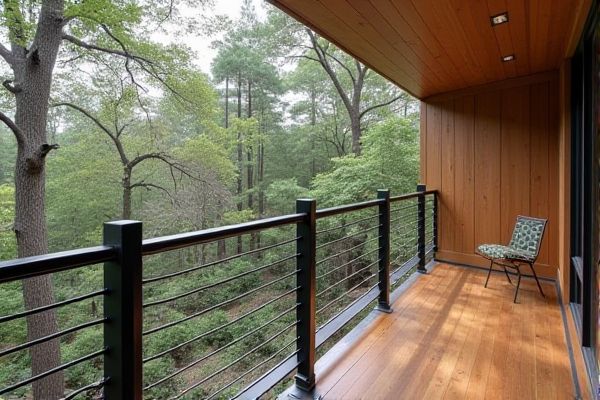
Steel railing offers superior durability, weather resistance, and low maintenance compared to wood railing, which can be prone to rot, warping, and requires regular upkeep. Explore the full article to understand how your terrace can benefit from choosing the right material for safety, aesthetics, and longevity.
Table of Comparison
| Feature | Steel Railing | Wood Railing |
|---|---|---|
| Durability | Highly durable, resistant to weather and corrosion | Moderate durability, prone to rot and insect damage |
| Maintenance | Low maintenance, occasional rust prevention needed | High maintenance, requires regular sealing or painting |
| Cost | Moderate to high initial cost, long-lasting | Lower initial cost, higher long-term maintenance costs |
| Appearance | Modern, sleek, industrial look | Natural, warm, traditional aesthetic |
| Installation | Requires welding and professional installation | Easier DIY installation, requires carpentry skills |
| Environmental Impact | Recyclable, long lifespan reduces waste | Renewable resource but may involve deforestation |
| Safety | Strong and sturdy, supports heavy loads | Strong but can weaken over time without maintenance |
Introduction to Terrace Railings: Steel vs. Wood
Terrace railings play a crucial role in safety and aesthetic appeal, with steel and wood being popular material choices. Steel railings offer durability, low maintenance, and modern design options, while wood railings provide natural warmth and customizable styles. Your decision depends on factors like weather resistance, cost, and desired visual impact for your terrace.
Aesthetic Appeal: Modern vs. Classic Looks
Steel railings offer a sleek, modern aesthetic characterized by clean lines and minimalist design, making them ideal for contemporary terraces. Wood railings provide a timeless, classic look with natural textures and warm tones that complement traditional and rustic outdoor spaces. Choosing between steel and wood depends on whether a modern, industrial vibe or a classic, organic charm is desired for the terrace.
Durability and Lifespan Comparison
Steel railings offer superior durability and a longer lifespan compared to wood railings, often lasting 20 to 30 years with minimal maintenance due to their resistance to rot, pests, and weather damage. Wood railings typically require frequent upkeep, such as sanding, staining, and sealing, and have an average lifespan of 10 to 15 years when exposed to outdoor conditions. The inherent strength of steel combined with corrosion-resistant coatings extends its structural integrity far beyond that of wood, making steel a more cost-effective choice for terrace railings over time.
Maintenance Requirements for Steel and Wood Railings
Steel railings require minimal maintenance, needing only occasional cleaning and inspection for rust or corrosion, especially if coated with weather-resistant paint or galvanization. Wood railings demand more frequent upkeep, including sanding, staining, or sealing every few years to protect against moisture, rot, and insect damage. The longevity of steel railings generally exceeds wood, making them a more durable and low-maintenance option for terraces exposed to varying weather conditions.
Safety and Strength Considerations
Steel railings offer superior strength and durability compared to wood, providing enhanced safety for terraces exposed to heavy use or harsh weather conditions. Unlike wood, which can warp, crack, or rot over time, steel maintains structural integrity and resists impact, ensuring long-term stability. Choosing steel railing for your terrace significantly reduces maintenance while maximizing safety for your outdoor space.
Weather Resistance: Performance in Outdoor Conditions
Steel railings exhibit superior weather resistance compared to wood railings, as steel is less susceptible to moisture, rot, and insect damage in outdoor terrace environments. Galvanized or powder-coated steel options provide enhanced corrosion resistance, ensuring long-term durability against rain, snow, and UV exposure. In contrast, wood railings require regular treatment and maintenance to prevent warping, cracking, and decay caused by fluctuating humidity and temperature changes.
Installation Process and Complexity
Steel railing installation requires precise measurements and welding or bolting techniques, often necessitating professional skills and specialized tools, making it more complex and time-consuming compared to wood. Wood railing installation is generally simpler, involving standard carpentry tools with fastening nails or screws, which can be handled by DIY enthusiasts with basic skills. Your choice between steel and wood railings may depend on your comfort level with installation complexity and the availability of professional assistance.
Cost Analysis: Upfront and Long-Term Expenses
Steel railings typically involve higher upfront costs due to material and fabrication expenses but offer lower long-term maintenance costs because of their durability and resistance to weathering. Wood railings generally have a lower initial price but require frequent maintenance such as staining, sealing, and repairs, increasing lifetime expenses. Evaluating total cost of ownership favors steel railings for long-term savings despite the higher initial investment.
Environmental Impact and Sustainability
Steel railing offers high sustainability due to its recyclability and long lifespan, reducing the need for frequent replacements and minimizing environmental waste. Wood railing, while renewable and biodegradable, often involves deforestation and requires treatments that may harm the environment. Choosing steel railing for your terrace supports eco-friendly construction by promoting resource efficiency and reducing carbon footprints.
Choosing the Right Railing Material for Your Terrace
Steel railing offers superior durability, corrosion resistance, and low maintenance, making it an ideal choice for terraces exposed to harsh weather conditions. Wood railing provides a warm, natural aesthetic with customization options but requires regular sealing and maintenance to prevent rot and insect damage. Selecting the right terrace railing material depends on prioritizing longevity, design preferences, and upkeep commitment.
 homyna.com
homyna.com